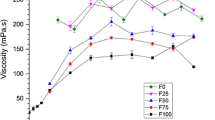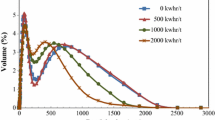Abstract
The rheology of cellulose microfibril suspensions from TEMPO-oxidized pulp was investigated. The suspension showed a pseudo-plastic and thixotropic behavior, slowly evolving with time under a given shear rate. The viscosity was proportional to the concentration up to the critical concentration of 0.23%. Above it, the viscosity followed a power law with exponents from 2 to 6 depending on the shear rate, and the system showed shear thinning behavior and behaved gel-like. Below this concentration, the system was more Newtonian. Birefringence measurement of 0.44% and 0.78% suspension showed that microfibrils alignment saturated at a small shear rate with a Herman’s orientation parameter below 0.65 probably due to the interconnection of microfibrils.








Similar content being viewed by others
References
Azuma J, Sakamoto M (2003) Cellulosic hydrocolloid system present in seed of plants. Trends Glycosci Glycotechnol 15:1–14
Barnes HA (1997) Thixotropy––a review. J Non-Newtonian Fluid Mech 70:1–33
Bercea M, Navard P (2000) Shear dynamics of aqueous suspensions of cellulose whiskers. Macromolecules 33:6011–6016
Dinand E, Chanzy H, Vignon MR (1996) Parenchymal cell cellulose from sugar beet pulp: preparation and properties. Cellulose 3:183–188
Dinand E, Chanzy H, Vignon MR (1999) Suspensions of cellulose microfibrils from sugar beet pulp. Food Hydrocolloids 13:275–283
Doi M, Edwards SF (1986) The theory of polymer dynamics, Chapter 7. Oxford University Press, New York, pp 218–288
Fuller GD (1995) Optical rheometry of complex fluids. Oxford University Press, New York
Herrick FW, Casebier RL, Hamilton JK, Sandberg KR (1983) Microfibrillated cellulose; Morphology and accessibility. J Appl Polym Sci: Appl Polym Symp 37:797–813
Hioki N, Hori Y, Watanabe K, Morinaga Y, Yoshinaga F, Hibino Y, Ogura T (1995) Bacterial cellulose; as a new material for papermaking. Jpn Tappi J 49:82–87
Krishna Iyer K, Neelakantan P, Radhakrishnan T (1968) Birefringence of native cellulosic fibers. I. Untreated cotton and ramie. J Polym Sc A-2 6:1747–1758
Lepoutre P, Robertson AA (1974) Colloidal solutions from sodium polyacrylate-polyacrylamide grafted cellulose. TAPPI 57:87–90
Marchessault RH, Morehead FF, Joan Koch M (1961) Some hydrodynamic properties of neutral suspensions of cellulose crystallites as related to size and shape. J Colloid Sci 16:327–344
Nakagaito AN, Yano H (2004) The effect of morphological changes from pulp fiber towards nano-scale fibrillated cellulose on the mechanical properties of high-strength plant fiber based composites. Appl Phys A 78:547–552
Nakagaito AN, Yano H (2005) Novel high-strength biocomposites based on microfibrillated cellulose having nano-order-unit web-like network structure. Appl Phys A 80:155–159
Nishiyama Y, Kim UJ, Kim DY, Katsumata KS, May RP, Langan P (2003) Periodic disorder along ramie cellulose microfibrils. Biomacromolecules 4:1013–1017
Saito T, Nishiyama Y, Putaux J-L, Vignon MR, Isogai A (2006) Homogeneous suspensions of individualized microfibrils from TEMPO-catalyzed oxidation of native cellulose. Biomacromolecules 7:1687–1691
Saito T, Kimura S, Nishiyama Y, Isogai A (2007) Nanofibers prepared by TEMPO-mediated oxidation of native cellulose. Biomacromolecules 8:2485–2491
Turbak AF, Snyder FW, Sandberg KR (1983) Microfibrillated cellulose, a new cellulose product; properties, uses, and commercial potential. J Appl Polym Sci: Appl Polym Symp 37:815–827
Vian B, Reis D, Darzens D, Roland JC (1994) Cholesteric-like crystal analogs in glucuronoxylan-rich cell wall composites: experimental approach of acellular re-assembly from native cellulosic suspension. Protoplasma 180:70–81
Wiener O (1912) Die Theorie des mischkörpers für das Feld der stationären Strömung. Abh Math-Phys Klasse königlich sächischen Ges Wiss 32:509–604
Yano H, Sugiyama J, Nakagaito AN, Nogi M, Matsuura T, Hikita M, Handa K (2005) Optically transparent composites reinforced with networks of bacterial nanofibers. Adv Materials 17:153–155
Zimmermann T, Pöhler E, Geiger T (2004) Cellulose fibrils for polymer reinforcement. Adv Eng Mat 6(9):754–761
Author information
Authors and Affiliations
Corresponding author
Rights and permissions
About this article
Cite this article
Lasseuguette, E., Roux, D. & Nishiyama, Y. Rheological properties of microfibrillar suspension of TEMPO-oxidized pulp. Cellulose 15, 425–433 (2008). https://doi.org/10.1007/s10570-007-9184-2
Received:
Accepted:
Published:
Issue Date:
DOI: https://doi.org/10.1007/s10570-007-9184-2




